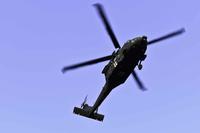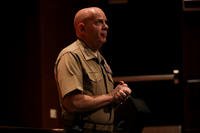Both chambers of Congress have competing ideas to reinvent the Army's new fitness test, an ongoing effort by legislators to alter fitness standards for the service that only last year received their first major update in decades.
As part of the draft of the must-pass National Defense Authorization Act, or NDAA, which directs policy and funds the Pentagon, the House Armed Services Committee introduced an amendment for the Army to implement gender-neutral standards for soldiers serving in combat arms.
It's a move that Army senior leaders and the rank and file would likely welcome. Some service planners behind the scenes were unhappy with the introduction of the Army Combat Fitness Test, or ACFT, last year, which ended up having different standards for men and women. Others argue grading women on the same scale as men while relying on those scores for promotions would be unfair.
Read Next: Lawmakers Look to Make Military Housing More Livable with Annual Defense Bill
Army planners were already looking into adjusting standards for combat jobs, including gender-neutral standards. One service official told Military.com, on the condition of anonymity to discuss internal deliberations, that one idea was adjusting minimum passing standards for frontline roles, making the current pass rate for 17- to 21-year-old men the blanket minimum for men and women in combat arms.
The job codes that would see higher and gender-neutral ACFT standards if the House's proposal passes would be: 11A, 11B, 11C, 12A, 12B, 13A, 13F, 18A, 18B, 18C, 18D, 18E, 18F, 18Z, 19A, 19D; as well as 25C and 68W assigned to infantry, cavalry and engineer line companies, and brigade combat teams. Those jobs cover infantry, field artillery, engineer, special forces and cavalry fields.
The draft NDAA is in the early stages and will go through a long series of negotiations between each chamber on Capitol Hill and key stakeholders, including the Army, before heading to President Joe Biden's desk for signature.
Military.com reported on Monday that the Senate's version of the draft NDAA includes a provision to revert the Army back to its old test, the Army Physical Fitness Test, or APFT. That idea drew ire from Sergeant Major of the Army Michael Grinston, the service's top enlisted leader. Grinston said that idea "doesn't make sense" after the Army spent a decade developing the ACFT -- a test that is broadly seen as a much better assessment of fitness.
A previous version of the ACFT in a pilot program in 2019 initially graded soldiers based on their jobs, though test developers told Military.com that quickly became problematic in situations where soldiers did not have a combat arms job but were assigned to a line unit or vice versa.
The ACFT was created to replace the prior fitness test, which had been in use since the 1980s and only measured push-ups, sit-ups and a timed two-mile run. The Army sought a new test around 2010 after years of conflict in Iraq and Afghanistan spurred a desire for a more comprehensive test.
The ACFT was tested in a trial period in 2019 and became the Army's test of record in October. The test consists of six events, including a deadlift, hand-release push-ups, a plank, a timed two-mile run; an event which soldiers sprint and switch between carrying 40-pound kettlebells and dragging a 90-pound sled for time, and an event in which soldiers throw a 10-pound medicine ball as far as they can.
-- Steve Beynon can be reached at Steve.Beynon@military.com. Follow him on Twitter @StevenBeynon.
Related: Congress' Move to Scrap the ACFT Sparks Outcry from Army Leadership











